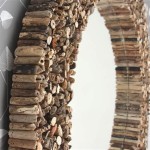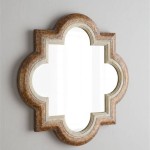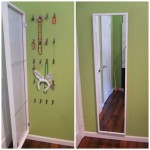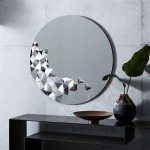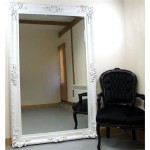Old Standing Mirror
Old standing mirrors, also known as cheval mirrors or full-length mirrors, hold a unique position in the world of antiques and interior design. More than simply reflective surfaces, they offer glimpses into bygone eras, reflecting the craftsmanship and aesthetic sensibilities of the past. These pieces often carry historical significance, connecting us to previous generations and their lifestyles.
Key Features of Old Standing Mirrors:
- Full-length reflection
- Freestanding design
- Variety of frame styles and materials
- Often feature adjustable tilting mechanisms
The earliest standing mirrors emerged in the 17th century, initially as expensive and luxurious items owned primarily by the wealthy. As glassmaking technology advanced and manufacturing costs decreased, these mirrors became more accessible to the wider population during the 18th and 19th centuries. This rise in popularity coincided with evolving fashion trends and a growing emphasis on personal appearance.
Common Frame Materials:
- Wood (mahogany, walnut, oak, pine)
- Giltwood (wood covered with gold leaf)
- Metals (brass, bronze, wrought iron)
- Lacquered or painted finishes
The frames of old standing mirrors showcase a remarkable range of styles, reflecting the dominant artistic movements of their respective periods. From the ornate carvings and gilded details of the Baroque and Rococo eras to the simpler, more streamlined designs of the Neoclassical and Art Deco periods, each frame tells a story about the prevailing tastes and craftsmanship of the time. These stylistic variations allow collectors and decorators to find mirrors that complement their specific aesthetic preferences.
Popular Styles of Old Standing Mirrors:
- Baroque/Rococo: characterized by ornate carvings, curves, and gilding
- Neoclassical: featuring simpler lines, classical motifs, and symmetry
- Victorian: often incorporating elaborate details, dark wood, and beveled glass
- Art Deco: showcasing geometric shapes, streamlined designs, and mirrored surfaces
The mirror glass itself also offers insights into a mirror's age and history. Early mirrors were often made using mercury glass, which can be identified by its slightly wavy or distorted reflection. Later mirrors utilized silvering techniques, producing a clearer and more accurate image. Examining the glass for signs of aging, such as foxing (brown spots) or silvering loss, can help determine the mirror’s authenticity and value.
Factors Affecting the Value of Old Standing Mirrors:
- Age and historical period
- Rarity of the style and materials
- Condition of the frame and mirror glass
- Provenance (history of ownership)
- Maker or manufacturer (if known)
Caring for an old standing mirror requires attention to its delicate nature. Regular dusting with a soft cloth is essential to prevent the buildup of dirt and grime. Avoid using harsh cleaning chemicals that can damage the frame or mirror. If the mirror glass requires cleaning, use a specialized mirror cleaner and a soft, lint-free cloth. For more extensive repairs or restoration work, consulting a professional conservator is recommended.
Tips for Caring for Old Standing Mirrors:
- Dust regularly with a soft cloth
- Avoid harsh cleaning chemicals
- Use specialized mirror cleaner for the glass
- Consult a professional for repairs or restoration
Incorporating an old standing mirror into a modern interior can add a touch of elegance and history to any space. These mirrors can serve as functional pieces in bedrooms, dressing rooms, or entryways, while also functioning as decorative focal points. Whether placed against a wall or used as a freestanding statement piece, an old standing mirror can enhance a room's aesthetic appeal and provide a tangible connection to the past.
Decorating with Old Standing Mirrors:
- Use in bedrooms, dressing rooms, or entryways
- Can be placed against a wall or freestanding
- Adds a touch of elegance and history to any space
- Serves as both a functional and decorative piece
The continued interest in old standing mirrors reflects a broader appreciation for antique furniture and decorative arts. These pieces are not merely functional objects; they are tangible representations of history, craftsmanship, and artistic expression. By understanding their history, styles, and care requirements, individuals can appreciate the unique qualities that old standing mirrors bring to both private collections and interior design.

Vintage Cheval Mirror Oak Standing Floor Tilting Vanity Boudoir Dressing Room Shabby Chic Traditional

Florence Antique French Vintage Standing Mirror West Mirrors

Cheval Mirrors Foter Floor Mirror Wall Victorian

Antique Victorian Carved Oak Free Standing Mirror For At Pamono

Vintage Full Length Mirror Bedroom Flooring House Design

20th Century Vintage Wooden Cheval Mirror Chairish

Refinished Vintage Walnut Standing Mirror Distressed Chalk Paint And Waxed Farmhouse Style Bedroom Decor Modern Design

Floor Standing Mirror Vintage Mahogany Out Of The Box

Hamar Vintage Mirror Antique Standing Or Wall Gold Frame Singaporehomefurniture

Standing Wood Mirror The Shabby Cottage Home
